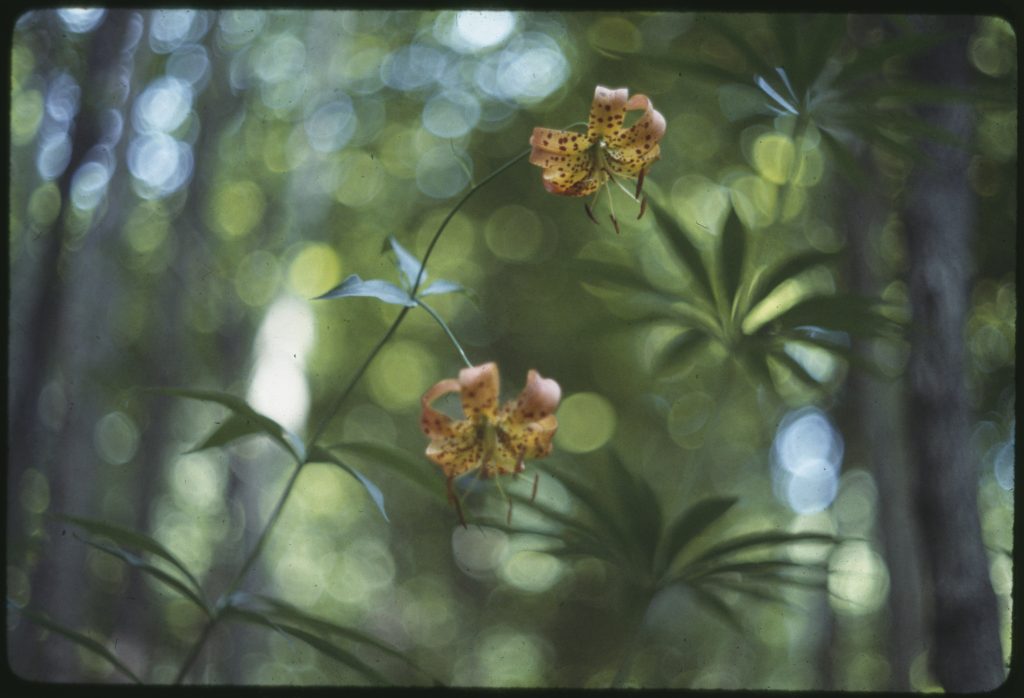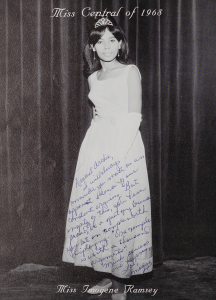
Miss Central of 1968, Imogene Ramsey, with autographed skirt
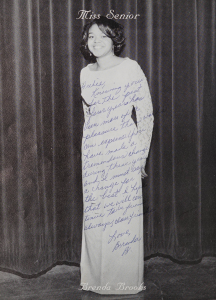
Autographed photo of Miss Senior of 1968, Brenda Brooks
If you want to know the insider info from Central High School in Hillsborough, N.C., the 1968 Bulldog yearbook would be a good place to start. The edition that we’ve recently digitized, provided by the Orange County Public Library, is full of marginalia and personal notes from its owner and his classmates.
The notes are addressed to “dearest Archie,” likely referring to Archie McAdoo, who was involved in many of the school’s activities. According to the Senior Statistics page, Archie was a part of the Debate Club, Student Council, Band, and Cheerleading, among other clubs. He was also voted “Most Musical” and “Most Ingenuous.”
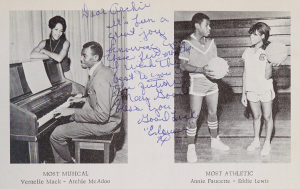
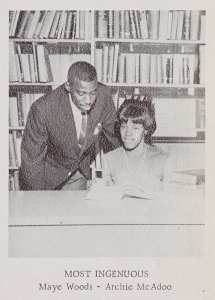
Many of the messages left by classmates cover huge swaths of the pages, including a few inscriptions that cover entire pages. Clearly, Archie was well-loved.
Click here to see the full 1968 Bulldog. For more from the Orange County Public Library, visit their partner page or their website.

We have over 60 titles up on DigitalNC this week! While these papers are from all over North Carolina, about a third are from western Carolina. 18 from Asheville, one from Morganton, as well as our first additions from Bryson City and Bakersville! Bakersville, which gives us The Mountain Voice, only has a population of 466, but is home to the North Carolina Rhododendron Festival. Started in 1947, the festival was a relatively small affair until Spruce Pine resident O.D. Calhoun came into the picture. Calhoun owned several movie theaters across North Carolina and apparently had contacts to Walt Disney. He used these connections to promote the festival and make it into a nationally renowned event. It’s estimated that between five and ten thousand people attended the festival when Richard Nixon made an appearance in 1958.
Over the next year, we’ll be adding millions of newspaper images to DigitalNC. These images were originally digitized a number of years ago in a partnership with Newspapers.com. That project focused on scanning microfilmed papers published before 1923 held by the North Carolina Collection in Wilson Special Collections Library. While you can currently search all of those pre-1923 issues on Newspapers.com, over the next year we will also make them available in our newspaper database as well. This will allow you to search that content alongside the 2 million pages already on our site – all completely open access and free to use.
This week’s additions include:
- The Blue Ridge Blade (Morganton, N.C.) – 1876-1881
- North Carolina Advertiser (Raleigh, N.C.) – 1865
- Carolina Beacon and Metropolitan Omnibus (Raleigh, N.C.) – 1840
- Republican Touchstone (Raleigh, N.C.) – 1840
- North-Carolina Statesman (Raleigh, N.C.) – 1854
- The Independent (Raleigh, N.C.) – 1843-1845
- Democratic Flag (Raleigh, N.C.) – 1848
- The American Signal (Raleigh, N.C.) – 1856
- The Daily Telegraph (Raleigh, N.C.) – 1862
- Weekly Ad Valorem Banner (Raleigh, N.C.) – 1861
- Daily Ad Valorem Banner (Raleigh, N.C.) – 1861
- The National Democrat (Raleigh, N.C.) – 1860
- The Randolph Bulletin (Asheboro, N.C.) – 1910-1912
- The Asheboro Courier (Asheboro, N.C.) – 1918-1921
- Asheville Semi-Weekly Journal (Asheville, N.C.) – 1879
- The Western Tribune (Asheville, N.C.) – 1885
- Mountain Home-Journal (Asheville, N.C.) – 1892
- The Asheville Advertiser (Asheville, N.C.) – 1890
- The Buncombe Reformer (Asheville, N.C.) – 1893
- The Skyland Herald (Asheville, N.C.) – 1886
- The Evening Journal (Asheville, N.C.) – 1889
- Asheville Spectator (Asheville, N.C.) – 1853-1858
- Town Topics (Asheville, N.C.) – 1887
- The Daily Advance (Asheville, N.C.) – 1884-1885
- Asheville Daily Advance (Asheville, N.C.) – 1885-1887
- The Asheville Advance (Asheville, N.C.) – 1887-1888
- The Asheville Register (Asheville, N.C.) – 1901-1905
- The State Reporter (Asheville, N.C.) – 1896
- The Smoky Mountain Times (Bryson City, N.C.) – 1895-1896
- Sylvan Valley News (Brevard, N.C.) – 1916
- The Weekly Citizen (Asheville, N.C.) – 1890
- Asheville Weekly Citizen (Asheville, N.C.) – 1890-1892
- The Albemarle Press (Albemarle, N.C.) – 1922-1925
- The Bayboro Sentinel (Bayboro, N.C.) – 1902-1913
- Columbian Repository (Chapel Hill, N.C.) – 1836
- The Chapel Hillian (Chapel Hill, N.C.) – 1891
- The Harbinger (Chapel Hill, N.C.) – 1833-1834
- Orange County Independent (Chapel Hill, N.C.) – 1894
- The Independent (Chapel Hill, N.C.) – 1894
- The Chapel Hill Weekly Gazette (Chapel Hill, N.C.) – 1857
- Chapel Hill Literary Gazette (Chapel Hill, N.C.) – 1857-1858
- The Chapel Hill Gazette (Chapel Hill, N.C.) – 1858
- Burke County Times (Morganton, N.C.) – 1917-1918
- The Morning Post (Raleigh, N.C.) – 1898
- North Carolina Temperance Union (Raleigh, N.C.) – 1842
- The Southern Advertiser, and Appendix to the “Southern Weekly Post” (Raleigh, N.C.) – 1853
- Democratic State Flag (Raleigh, N.C.) – 1848
- The Deaf Mute (Raleigh, N.C.) – 1850
- North Carolina State Advertiser (Raleigh, N.C.) – 1871
- The Mercury (Raleigh, N.C.) – 1864
- The Progressive Farmer (Raleigh, N.C.) – 1919
- The Post (Wilmington, N.C.) – 1869
- Western Carolina Advocate (Asheville, N.C.) – 1892-1983
- Daily Charlotte Observer (Charlotte, N.C.) – 1886
- North Carolina Christian Advocate (Raleigh, N.C.) – 1912-1917
- The Cape-Fear Recorder (Wilmington, N.C.) – 1816-1829
- The High Point Enterprise (High Point, N.C.) – 1886
- Asheville Gazette-News (Asheville, N.C.) – 1914
- The Mountain Voice (Bakersville, N.C.) – 1880
- The Daily Bulletin (Charlotte, N.C.) – 1859-1876
- The Evening Bulletin (Charlotte, N.C.) – 1880
If you want to see all of the newspapers we have available on DigitalNC, you can find them here. Thanks to UNC-Chapel Hill Libraries for permission to and support for adding all of this content as well as the content to come. We also thank the North Caroliniana Society for providing funding to support staff working on this project.

This week we are sharing the second installment of titles on DigitalNC that were brought to us by the National Digital Newspaper Program (NDNP) in a cooperative effort with the North Carolina Collection at UNC-Chapel Hill Libraries.
The NDNP is a partnership between the National Endowment for the Humanities and the Library of Congress with the intention of creating a vast, searchable database of newspapers and other historical documents. You can currently search all of the NDNP issues on the Library of Congress’ Chronicling America website. Those same issues will be available on our newspaper database, allowing you to search that content alongside the other papers on DigitalNC. The week’s titles are the following:
- Watauga Democrat (Boone, N.C.) – 1888-1934
- Carolina Watchman (Salisbury, N.C.) – 1931-1937
- The Tarborough Southerner (Tarboro, N.C.) – 1848-1876
- The Charlotte Democrat (Charlotte, N.C.) – 1853-1887
- Weekly Standard (Raleigh, N.C.) – 1836-1858
- Marion Progress (Marion, N.C.) – 1930-1931
- The News and Views (Jacksonville, N.C.) – 1942-1952
- Fisherman & Farmer (Edenton, N.C.) – 1889-1901
- The Farmer and Mechanic (Raleigh, N.C.) – 1877-1915
- The Free Press (Southern Pines, N.C.) – 1898-1905
- The Commonwealth (Scotland Neck, N.C.) – 1888
- The Review (High Point, N.C.) – 1910-1921
- Rockingham Post-Dispatch (Rockingham, N.C.) – 1917-1922
- French Broad Hustler (Hendersonville, N.C.) – 1905-1919
- The Durham Daily Globe (Durham, N.C.) – 1887-1894
- The Wilmington Messenger (Wilmington, N.C.) – 1897-1908
- Journal of Freedom (Raleigh, N.C.) – 1865
- The Sun (Fayetteville, N.C.) – 1883-1885
- The North-Carolinian (Fayetteville, N.C.) – 1842-1857
- Wilmington Morning Star (Wilmington, N.C.) – 1941-1946
- The Robesonian (Lumberton, N.C.) – 1872-1918
- Western Sentinel (Winston-Salem, N.C.) – 1886
- The State Chronicle (Raleigh, N.C.) – 1883-1892
- The Daily Caucasian (Raleigh, N.C.) – 1895
- The Gold Leaf (Henderson, N.C.) – 1882-1911
- The Caucasian (Clinton, N.C.) – 1884-1913
- The Durham Recorder (Durham, N.C.) – 1879-1911
- The Hillsborough Recorder (Hillsborough, N.C.) – 1836-1879
- Henderson Daily Dispatch (Henderson, N.C.) – 1932-1940
- Hillsboro Recorder (Hillsborough, N.C.) – 1887-1888
- The Carolinian (Raleigh, N.C.) – 1935-1939
- The Lincoln Times (Lincolnton, N.C.) – 1935-1962
- The Southern News (Asheville, N.C.) – 1938-1962
- Charlotte Messenger (Charlotte, N.C.) – 1882-1889
- The Weekly Intelligencer (Fayetteville, N.C.) – 1864-1865
- The Educator (Fayetteville, N.C.) – 1874-1875
- The Chapel Hill Weekly (Chapel Hill, N.C.) – 1930-1934
- Wilmington Journal (Wilmington, N.C.) – 1844-1876
- Cherokee Scout (Murphy, N.C.) – 1890-1917
- The Daily Confederate (Raleigh, N.C.) – 1864-1865
- The Gazette (Raleigh, N.C.) – 1891-1898
- Our Living and Our Dead (New Bern, N.C.) – 1873-1874
- North Carolina Republican (Raleigh, N.C.) – 1880
- Weekly Confederate (Raleigh, N.C.) – 1864-1865
- The Monroe Journal (Monroe, N.C.) – 1903-1922
- The Journal of Industry (Raleigh, N.C.) – 1879-1880
- North Carolina Gazette (Raleigh, N.C.) – 1885
- The Skyland Post (West Jefferson, N.C.) – 1935-1947
- The Coastland Times (Manteo, N.C.) – 1951-1962
- The Burke County News (Morganton, N.C.) – 1899-1900
- The Fool-Killer (Boomer, N.C.) – 1910-1922
- Orange County Observer (Hillsborough, N.C.) – 1880-1916
This concludes the list of newspapers that we are sharing from the NDNP. If you want to see all of the newspapers we have available on DigitalNC, you can find them here. Thanks to UNC-Chapel Hill Libraries for permission to and support for adding all of this content as well as the content to come. We also thank the North Caroliniana Society for providing funding to support staff working on this project.
Back in December, we announced our annual call for microfilmed newspaper digitization. We asked institutions throughout North Carolina to nominate papers they’d like to see added to DigitalNC. As it is every year, it was an incredibly tough choice – we are typically able to choose between 40-60 reels out of over 500+ nominated. This year we’ve chosen the following titles and years.
| Title |
Years |
Nominating Institution |
| The Elkin Tribune (Elkin, N.C.) |
1942-1949 |
Elkin Public Library |
| The Enterprise (Williamston, N.C.) |
1943-1954 |
Martin Community College and Martin Memorial Public Library |
| Gates County Index (Gatesville, N.C.) |
1942-1956 |
Gates County Public Library |
| Green Line (Asheville, N.C.) |
1987-1994 |
Buncombe County Public Libraries |
| The News of Orange County (Hillsborough, N.C.) |
1944-1964 |
Orange County Public Library |
| The Pamlico News (Bayboro, N.C.) |
1976-1987 |
New Bern-Craven County Public Library |
| The Pilot (Southern Pines, N.C.) |
1965-1968 |
Southern Pines Public Library |
| The Smithfield Herald (Smithfield, N.C.) |
1911-1925 |
Johnston County Heritage Center |
| The Wallace Enterprise (Wallace, N.C.) |
1931-1955 |
Thelma Dingus Bryant Library |
| Winston-Salem Chronicle (Charlotte, N.C.) |
2017-2018 |
Forsyth County Public Library |
For our selection criteria, we prioritize newspapers that document underrepresented communities, new titles, papers that come from a county that currently has little representation on DigitalNC, and papers nominated by new partners. After selection, we ask the partners to secure permission for digitization and, if that’s successful, they make it into the final list above.
We hope to have these titles coming online in the first half of 2021. If your title didn’t make it this year don’t despair! We welcome repeat submissions, and plan on sending out another call in Fall 2021.
Almost a hundred new maps and blueprints have been digitized and added to DigitalNC, courtesy of our partner, the Chapel Hill Historical Society. Dated from 1875 to June 2007, these maps illustrate how much the city of Chapel Hill and Orange County has changed in the last century and a half.
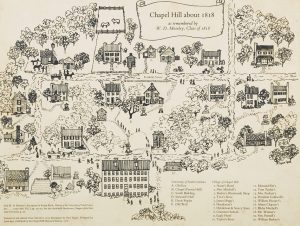
A map of how Chapel Hill would have appeared in 1818. Franklin St and Columbia St are featured.
This new batch contains many different types of maps and blueprints, including maps of Chapel Hill neighborhoods, site plans for individual properties, blueprints of the Chapel Hill Public Library and its additions, maps of the city’s outer limits, and township tax maps.
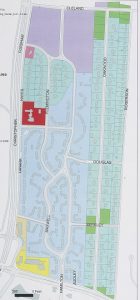
A color-coded map of the Glen Lennox properties circa 2008
Beyond recent maps of Chapel Hill, this batch also includes several other interesting items. One map sketches Orange County, as well as the neighboring counties that ceded land between the years of 1752 and 1849. Another sketches the state of North Carolina as it appeared in 1753, when Anson and Rowan Counties stretched to the west. Another map, from 1976, sketched Chapel Hill as it would have appeared in 1818.
Other items in the collection tell their own Chapel Hill stories. In 1925, R.L. Strowd, a local landowner, sold a number of lots throughout Orange County, and those deeds of land sales are also included in this collection. Another record of land sale is included, when Samuel Morgan sold land to Jesse Hargraves in 1845 for the cost of $4,300. This batch of items also includes a book that contains detailed maps of the Chapel Hill and Carrboro area from the 1960s through the 1980s, as well as an informational pamphlet from 1953 advertising the Lake Forest neighborhood of Chapel Hill.
By adding yet more maps, blueprints and artifacts to our collection, we can learn and understand more about the city that DigitalNC calls home. To see more materials from the Chapel Hill Historical Society, visit their contributor page or check out their website.
Monday Matchup
Here on our blog, we occasionally feature “matchups” that showcase relationships between different items in our collection. Today’s matchup? Illustrations in yearbooks from Salem Academy (Winston-Salem) and Elizabeth College (Charlotte).
An idle interest in the illustration below led to today’s rather extensive blog post.
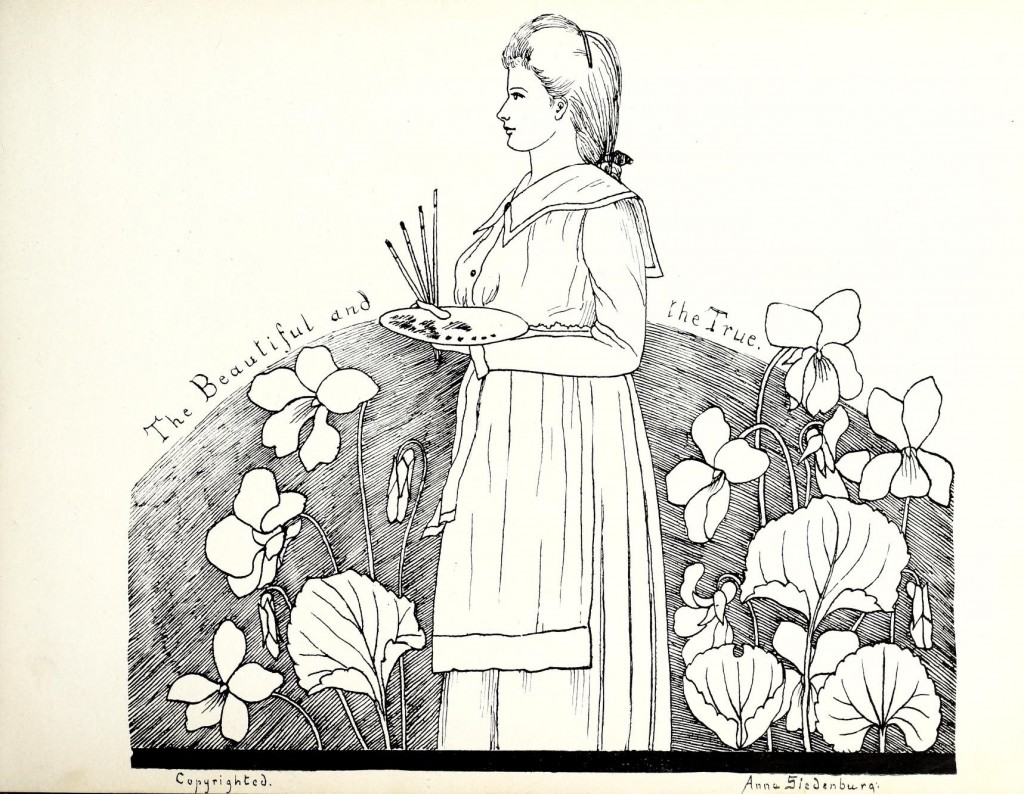
Illustration by Anna Siedenburg from Elizabeth College’s Caps and Belles yearbook, 1901
It wasn’t the artwork that caught my eye, albeit the image is lovely, but the inscription of “copyrighted” at the bottom. This isn’t something I’ve ever noticed accompanying such an early hand-drawn yearbook illustration (and I’ve looked at a lot of them). So I began investigating this copyright-aware student artist… and discovered it wasn’t a student, but a faculty member. Using just the collection at DigitalNC, I was able to unfold a good bit more about this woman: Anna Magdelene Siedenburg.
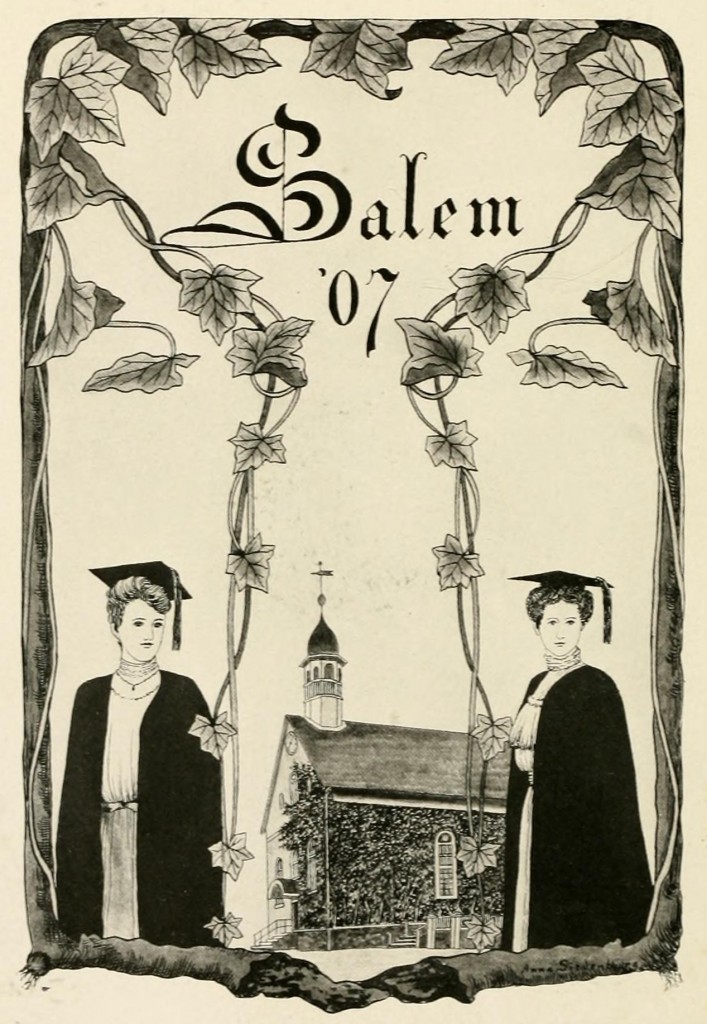
Siedenburg illustration from the 1907 Salem College Sights and Insights
Signed illustrations by Siedenburg can be found in the 1901 yearbook for Elizabeth College, from which the image above is taken, as well as yearbooks from Salem Academy and College in 1906 and 1907 (see right). There are a good number of unsigned illustrations that could be her work as well, or perhaps they are by students emulating her style.
From these yearbooks, I was able to piece together that Siedenburg taught at the two institutions mentioned above from at least 1900 to 1912. She was president and faculty sponsor of art clubs at both schools, and is listed as an instructor in drawing and painting (especially on ceramic and glass), as well as French and German.
But where did she come from? The Salem catalog for 1906 states her accomplishments: exhibiting in large American cities like New York, and winning various medals of excellence as well as designing for “leading art journals.” For more information I had to move beyond items on our site.
Anna Siedenburg was born in Bremen, Germany on February 23, 1854.* I’m unsure when she arrived in the United States, but if she traveled to North Carolina around 1900 she would have been a seasoned artist in the mature part of her career at age 46. I was able to track down more information using what was hinted at in the 1906 Salem College catalog. Siedenburg’s name is peppered throughout The Art Amateur from 1892-1900. She is both subject and author, with reviews of her exhibitions along with articles she wrote about painting on glass and advertisements for her as an instructor. Through the Amateur I learned that she lived in Cinncinnati in 1892, Chicago in 1895, and New York in 1898.** During this same time period (late 1890s-1900), Siedenburg authored several books on painting as well as a curious little volume of Fairy Tales and Fancies, which she illustrated. (List of her authored publications on WorldCat.)
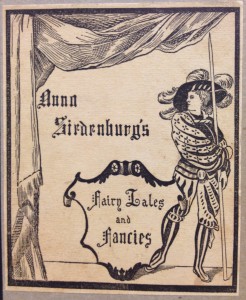
The cover of Fairy Tales and Fancies, by Anna Siedenburg, Chicago, 1895. Courtesy Davis Library, UNC Chapel Hill.
It’s hard not to try and imagine the personality of a moderately successful female artist of that time period who traveled widely and seemingly on her own, eventually making her way to North Carolina to devote time to instructing young women. She seems to have been a thoughtful woman who was well liked by her students; the 1906 Salem College yearbook includes a poem entitled “My Seniors,” in which she expresses especial affinity for the graduating class. She was creative. Her book of original Fairy Tales includes a good number of princesses but also strays beyond the stereotypical, as in “Just a Match” which is an allegorical tale about, well, a match.
The other pieces of personal information I could find are few, but include a reference to a friend visiting her at a cottage called “Galax,” in Blowing Rock.*** I also know she died, single, in Winston-Salem on November 12, 1926.* She was buried in God’s Acre, the Moravian cemetery that’s now part of Old Salem.
My hope was to find a picture of her in one of the yearbooks on our site, but most of the faculty photos were unreliably labeled. Thankfully, I have something even better. It’s with pleasure that I can present this photo, cheerfully provided by the archives at Salem College, of Anna Siedenburg.
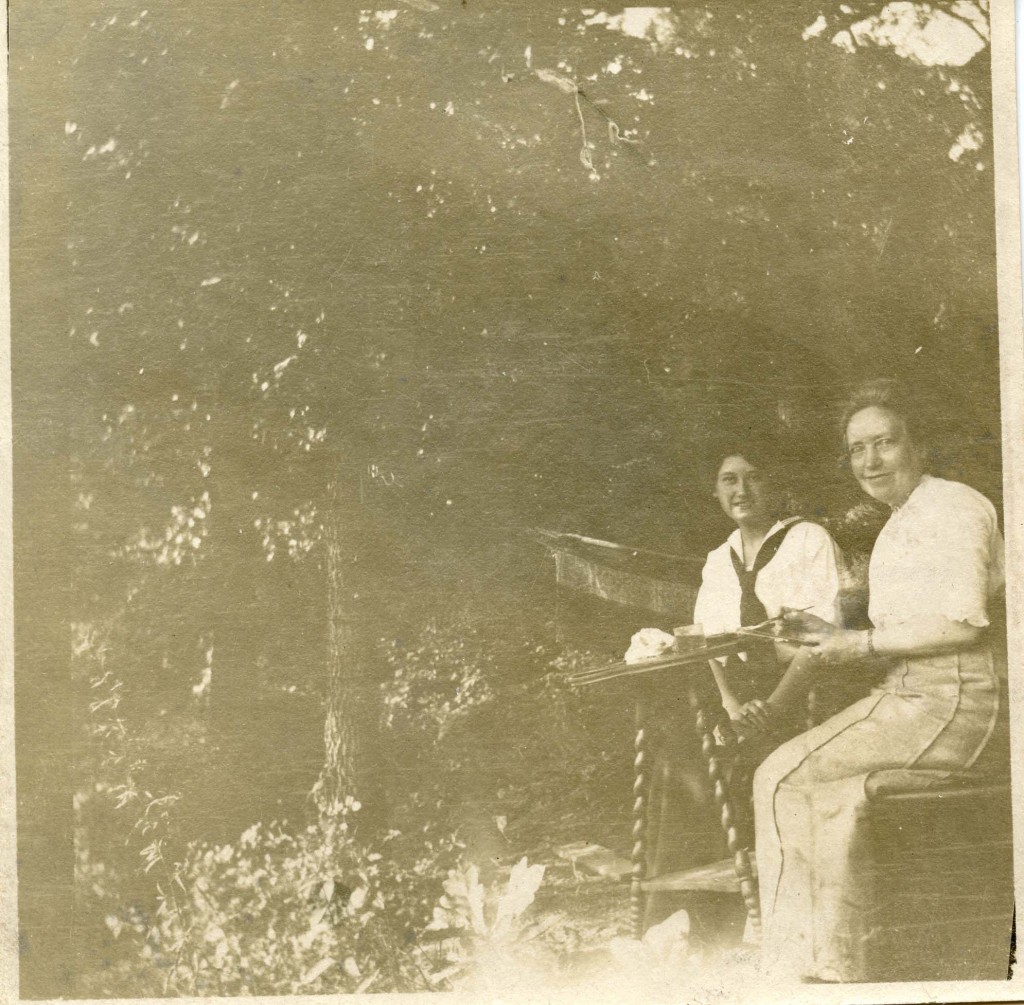
Undated photograph of Pauline Bahnson (left) and Anna M. Siedenburg. Bahnson graduated Salem College in 1910. Courtesy Salem College Archives.
*Source: Ancestry.com. North Carolina, Death Certificates, 1909-1975 [database on-line]. Provo, UT, USA: Ancestry.com Operations Inc, 2007. Original data: North Carolina State Board of Health, Bureau of Vital Statistics.North Carolina Death Certificates. Microfilm S.123. Rolls 19-242, 280, 313-682, 1040-1297. North Carolina State Archives, Raleigh, North Carolina.
** The Art Amateur (February 1898) p. 76.
***The Orange County Observer newspaper (June 25, 1908) p. 3.
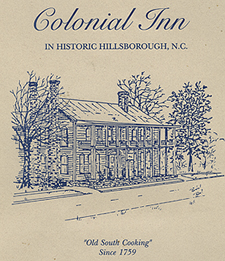
The Colonial Inn of Hillsborough, N.C., was a popular destination for Sunday dinner for many years before it closed its doors to the public in 2001. However, exactly how many years it served those dinners is a topic somewhat disputed. According to this menu from the Orange County Historical Museum, as well as the sign in front of the building, the Inn was built in 1759, and through the years was purported to have housed such distinguished guests as General Cornwallis and Aaron Burr. But this website about the history of the Inn states that it wasn’t built until 1838, after both Cornwallis and Burr had died.
Perhaps a more reliable fact from the menu is that for Sunday dinner in 2001, you could get the ‘famous’ Southern fried chicken, a la carte, for $8.95, as compared to the price listed in the Inn’s 1949 menu: $1.25, including ‘hot rolls and beverage’.
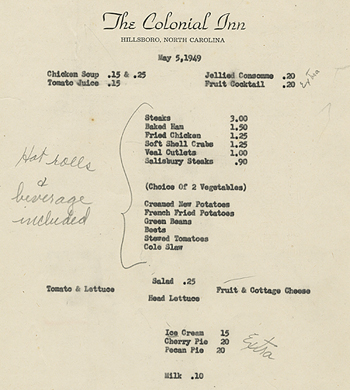
Thanks to our partner, Southwestern Community College (SCC), a new batch of materials are now available on DigitalNC! This batch has over 190 new records that include a Great Smoky Mountains trail map, local histories, previous course catalogs, various newsletters, SCC program pamphlets, over 100+ photograph slides showcasing the college campus and nearby beautiful mountain views.
Located in the beautiful mountains of North Carolina, Southwestern Community College held its first classes on December 1, 1964 under the name “Jackson County Industrial Education Center.” During that time, the school was a satellite of Asheville-Buncombe Technical Institute. In September 1967, however, the satellite became an independent school and was renamed Southwestern Technical Institute (STI). The school’s name changed once more in 1979 to Southwestern Technical College before becoming Southwestern Community College in 1988.
The years following STI’s independence from Asheville-Buncombe Technical Institute were filled with construction of buildings, receiving accreditation from the Southern Association of Colleges and Schools, their first on-campus commencement ceremony, establishment of the Cherokee Center, and much more. Today, SCC has facilities across several counties as well as on the Qualla Boundary, is the only community college in the nation to enter into a cooperative science agreement with NASA, and offers over 40 academic programs for students to choose from.
To learn more about Southwestern Community College, please visit their website linked here.
To view more materials from Southwestern Community College, please visit their partner page linked here.
To view more materials from community colleges across North Carolina, please view our North Carolina Community College Collections exhibit linked here.
Information about SCC was gathered from the college’s College History page located on their website linked here.

This week we have another 30 newspaper titles up on DigitalNC! In the September 3, 1891 issue of Boone’s Watauga Democrat we have an article describing the terrible train wreck of Bostian’s Bridge in Statesville. This fatal accident sparked a legendary North Carolina ghost story, but perhaps even scarier are the boogeymen railroad companies would often create to avoid accountability: train wreckers.
-

-
Watauga Democrat, September 3, 1891
-
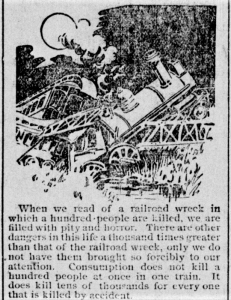
-
News and Observer, July 7, 1898
By 1891 the railroad system in America had exploded, allowing for easier cross-country travel and bringing with it fresh new paranoia about disasters and scary strangers coming to your town. Blaming a wreck on some shady character was a lot easier than paying a fortune on settlements due to negligence. Almost immediately after the August 27, 1891 accident, the Richmond & Danville Railroad Company put out ads offering a $10,000 reward for the apprehension of the perpetrator, leading to many being accused and arrested (conveniently with the help of a railroad detective).
-
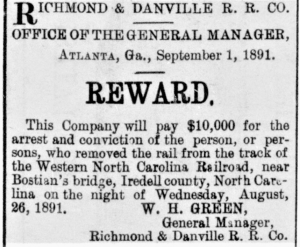
-
News & Observer, September 4, 1891
-
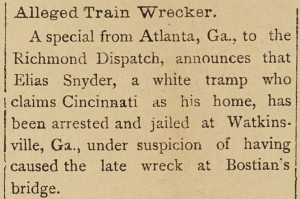
-
Greensboro Workman, September 16, 1891
-
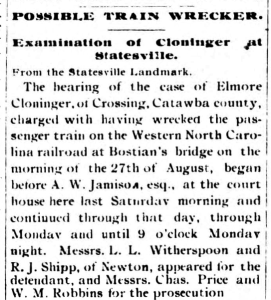
-
Asheville Citizen, October 15, 1891
-
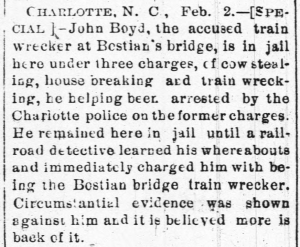
-
Wilmington Messenger, February 3, 1892
-
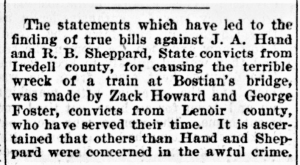
-
News & Observer, August 29, 1897
-
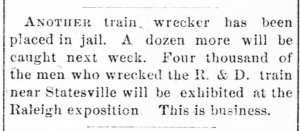
-
Durham Daily Globe, September 26, 1891
The editor at Statesville’s Landmark provides us with an incredibly detailed account of the accident and the recovery effort, complete with interviews from survivors and witnesses where they describe rotten cross-ties and rail workers throwing this evidence into the creek below the bridge. Many of those interviewed make a point to mention that there were no signs of robbery after the crash, which doesn’t exactly support the idea of this being some dastardly deed by a bandit.
Over the next year, we’ll be adding millions of newspaper images to DigitalNC. These images were originally digitized a number of years ago in a partnership with Newspapers.com. That project focused on scanning microfilmed papers published before 1923 held by the North Carolina Collection in Wilson Special Collections Library. While you can currently search all of those pre-1923 issues on Newspapers.com, over the next year we will also make them available in our newspaper database as well. This will allow you to search that content alongside the 2 million pages already on our site – all completely open access and free to use.
This week’s additions include:
Asheville
Boone
Burlington
Chapel Hill
Durham
Fayetteville
Fairfield
Gastonia
Holly Springs
Jackson
Kinston
Lexington
Lincolnton
Pittsboro
Raleigh
Salisbury
Tarboro
Winston
If you want to see all of the newspapers we have available on DigitalNC, you can find them here. Thanks to UNC-Chapel Hill Libraries for permission to and support for adding all of this content as well as the content to come. We also thank the North Caroliniana Society for providing funding to support staff working on this project.

This week we have added issues from 35 different newspaper titles! One of the titles we have is a paper from the now non-existent town of Buffalo Springs, North Carolina. According to this News & Record article, the Harnett County town ceased to exist when the turpentine industry in the area died out. But the intriguing thing about these papers isn’t the ghost of this town, it’s the man who wrote them: John McLean Harrington. Professor and author Michael Ray Smith penned this fascinating paper about Harrington and his newspapers, in which he writes: “Shortly before the Civil War, the son of an affluent Southern family began a journalism career unlike any in his community, his state, or even the nation and produced 305 handwritten newspapers, perhaps the greatest single output of handwritten newspapers by any American journalist.” Harrington had a subscription list of roughly 100 people and would painstakingly copy each individual paper by hand, even though printing presses were widely available at the time. In 1858, when Harrington was writing issues of The Nation, he was only 19 years old. The young man’s ambitions didn’t stop with just being a journalist. He also apparently worked as a bookkeeper, surveyor, educator, sheriff, and postmaster in Harnett County. While his accomplishments were quite impressive, he was also a man of contradiction. Smith writes this of the rural Renaissance man: “He talked of a partner but never revealed the colleague’s identity—if he indeed had one. He discussed the evil of drinking but died an alcoholic. He served as a member of the Confederate militia only to swear an oath that he would always remain a loyal Unionist. Perhaps Harrington tended to do or say whatever was expedient or expected at the time. Maybe he was himself just conflicted in numerous ways.”
Over the next year, we’ll be adding millions of newspaper images to DigitalNC. These images were originally digitized a number of years ago in a partnership with Newspapers.com. That project focused on scanning microfilmed papers published before 1923 held by the North Carolina Collection in Wilson Special Collections Library. While you can currently search all of those pre-1923 issues on Newspapers.com, over the next year we will also make them available in our newspaper database as well. This will allow you to search that content alongside the 2 million pages already on our site – all completely open access and free to use.
This week’s additions include:
- The Tri-Weekly Bulletin (Charlotte, N.C.) – 1865-1881
- Asheville Pioneer (Asheville, N.C.) – 1867-1869
- Weekly Pioneer (Asheville, N.C.) – 1870-1874
- The Carolina Eagle (Hickory, N.C.) – 1871-1872
- Mountain Messenger (Jefferson, N.C.) – 1873
- Battleboro Advance (Rocky Mount, N.C.) – 1871-1873
- The Weekly Ansonian (Polkton, N.C.) – 1876-1877
- The Southern Mail (Hillsborough, N.C.) – 1880
- The Carolina Republican (Lincolnton, N.C.) – 1848-1853
- Yadkin & Catawba Journal (Salisbury, N.C.) – 1828-1833
- The Journal (Salisbury, N.C.) – 1833-1834
- The Hornet (Bixby, N.C.) – 1908
- The Courier (Asheboro, N.C.) – 1922-1924
- The Asheville Democrat (Asheville, N.C.) – 1889-1891
- Monthly Gleaner (Asheville, N.C.) – 1894-1895
- Fuller’s Gleaner (Asheville, N.C.) – 1895-1896
- The Dispatch (Bessemer City, N.C.) – 1912
- The Carthage Blade (Carthage, N.C.) – 1887-1895
- The Central Times (Dunn, N.C.) – 1895
- County Union (Dunn, N.C.) – 1895-1899
- The Transylvania Hustler (Brevard, N.C.) – 1893
- The Brevard Hustler (Brevard, N.C.) – 1896
- The Western Carolina Democrat (Bakersville, N.C.) – 1888
- Roan Mountain Republican (Bakersville, N.C.) – 1876-1879
- The Nation (Buffalo Springs, N.C.) – 1858
- Cape Fear News (Fayetteville, N.C.) – 1915-1917
- Central Argus (Hamlet, N.C.) – 1880
- The Stanly Enterprise (Albemarle, N.C.) – 1903-1907
- The Albemarle Enterprise (Albemarle, N.C.) – 1912-1916
- The Stanly News-Herald (Albemarle, N.C.) – 1920-1922
- The Beaufort News (Beaufort, N.C.) – 1920-1922
- The State Dispatch (Burlington, N.C.) – 1908-1909
- Daily Carolina Times (Charlotte, N.C.) – 1864-1869
- The Standard (Concord, N.C.) – 1900-1902
- The Battleboro Progress (Battleboro, N.C.) – 1880
If you want to see all of the newspapers we have available on DigitalNC, you can find them here. Thanks to UNC-Chapel Hill Libraries for permission to and support for adding all of this content as well as the content to come. We also thank the North Caroliniana Society for providing funding to support staff working on this project.















